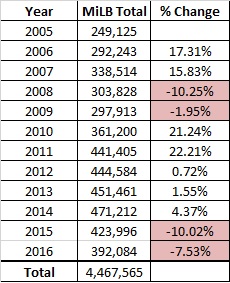Over the last few weeks, I have been exploring monthly attendance averages for baseball teams in the Tampa Bay area. I used 2007 as a start date for my research as 2007 was the Rays last year of being the Devil Rays and it was the first year of the Stu Sternberg ownership.
Before we dig into attendance, let's look at two major factors driving attendance: possible people and money available.
For possible people, we'll use the metro population of Tampa Bay from 2007 to 2016:
Difference: +8%
For money available, we'll use Adjusted Median Household Income.
Overall difference between Tampa Bay area median household income 2007 to 2015: -8.2%
The following chart shows the change in average monthly attendance from 2007 to 2016 attendance.
The Marauders had not yet begun play in 2007, so hence the N/As.
Let's explore month by month:
April:
Rays average April attendance in 2007 was 10% higher than it was in 2016. The Rays had 1,937 less fans per game in 2016 than they did in 2007. In 2007, the team started 5-6 and they started 8-7 in 2016. There is also increased awareness in the team and a record of success from 2008-2013.
Meanwhile, every Minor League team in the Tampa Bay area has seen an April attendance increase since 2007. Minor League attendance has increased an average of 1,134 total in April.
- Threshers: +660
- Yankees: +276
- Blue Jays: +198
It is possible some fans opted to go to Minor League Baseball games in the nice Florida April weather than to go to the domed Tropicana Field.
May:
Rays attendance in May 2016 was 38% more than it was in May 2007. The Rays drew 3,000 more on weekdays and nearly 4,000 more per game on weekends in 2016 than they did in 2007. Rays average May attendance in 2015 was actually lower than it was in 2007, so much of the gain was due to something done for 2016.
Minor League average attendance differences were varied between 2007 and 2016.
- Blue Jays: 111
- Threshers: 72
- Yankees: -1,824
Again, a bit misleading in regards to the Yankees since May 2007 Yankees attendance was highlighted by a Roger Clemens rehab assignment that drew 10,000 fans.
June:
Again, the Rays saw a large increase in June average attendance compared to their June 2007 average attendance, drawing over 3,700 more fans per game. This was not only due to the sellout for Pride Night either. Without Pride Night, the Rays still had over 1,000 more fans per game in June 2016 than they did in June 2007.
Minor League June average attendance increased in the case of the Threshers, saw little variance in Dunedin, and decreased in Tampa.
- Threshers: 106
- Blue Jays: 6
- Yankees: -689
July:
A second month where Rays average attendance was lower in 2016 than it was in 2007. We can probably attribute this to lower attendance in games versus the Yankees and Red Sox, neither of whom are the draw they used to be.
July attendance for Threshers increased the most (534 per game), followed by the Blue Jays with 252 per game. We might assume these July increases are mostly because of increased 4th of July extravaganzas.
Meanwhile, Tampa Yankees attendance in July 2016 was 366 fans less per game than Tampa Yankees attendance in July 2007.
August:
The Rays struggled through attendance in August 2016. August 2007 wasn't great, but it was consistently higher with attendance ranging from 23,000 to 10,000.
While Threshers attendance marginally increased, August attendance for both the Blue Jays and the Yankees plummeted.
September:
With Minor League Baseball season complete, the Rays no longer face any regional baseball competition for eyes, butts, or dollars. The Rays drew 27% worse per game in September 2016 than they did in September 2007.
Perhaps this is due to expectations. Perhaps it is due to games against the Yankees and the Red Sox not drawing as well. Perhaps it is because household income has decreased and people are going to games in the summer when the kids are out of school, but not in April or August/September.
While 240,000 more people live in Tampa Bay since 2007, we are seeing only limited increases in baseball attendance. If 50% of the 240,000 are baseball fans (national average), then there is the potential for gains across the board. So far we are not seeing that.
Average difference per game 2007 to 2016:
- Threshers: +230
- Blue Jays: +49
- Yankees: -680
- Rays: -1,587
Are these people not baseball fans? Do they live near any stadium? I could assume they are going to Spring Training only, but total Spring Training attendance in 2016 is 50,000 less than total Spring Training attendance in 2007, albeit with the relocation of the Rays from Al Lang Field in St. Pete to Port Charlotte.
Perhaps a growing economy, more jobs, and an increased population will boost baseball attendance in Tampa Bay. But with increasing market competition from the Lightning, Bucs, Rowdies, and USF sports, baseball in Tampa Bay has a tough road to travel.

























































